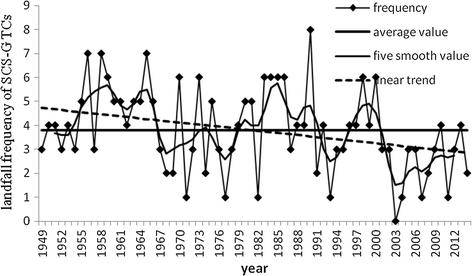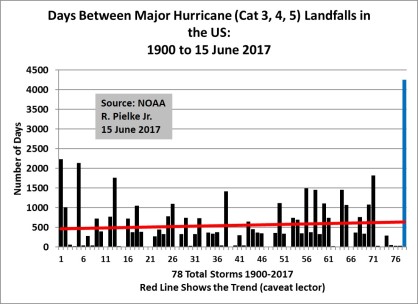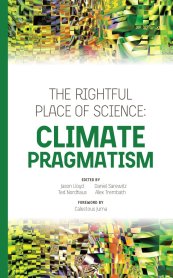 Welcome to issue #3 of my occasional newsletter on climate and energy issues. As a reminder, my day-to-day research or writing is focused on sports governance and various issues of science policy. But I’ve written a fair bit on the topics of climate and energy over the past 25 years, including two recent books and a boatload of academic papers, and I’m paying attention. So caveat lector!
Welcome to issue #3 of my occasional newsletter on climate and energy issues. As a reminder, my day-to-day research or writing is focused on sports governance and various issues of science policy. But I’ve written a fair bit on the topics of climate and energy over the past 25 years, including two recent books and a boatload of academic papers, and I’m paying attention. So caveat lector!
A few things to say up front:
- If you don’t like what I write or don’t like me, then don’t read it – no big deal, I’m just a professor with a blog.
- If you appreciate the perspective, consider the tip jar to your right. And thanks to those of you who have tipped – very much appreciated!
- If you’d like to engage, consider a comment, a Tweet to me (@rogerpielkejr) or an email. I am happy to discuss or debate. I’ve had great feedback on the first 2 issues.
- If you choose to call me names or lie about me, oh-so-common in discussing climate, then you will be blocked or ignored.
With that, some of what I found interesting over the past month . . .
BP Statistical Review of World Energy
Every June, BP publishes one of the world’s best resources on global energy consumption. BP data was at the heart of the analyses I did in The Climate Fix, and are essential for understanding climate and energy policy issues. Here are some analyses based on the just released 2017 data following a methodology described here (in PDF) and here (in much more depth).
- If a goal of climate policy is to stabilize carbon dioxide concentrations in the atmosphere at a low level (e.g., 450 ppm) then emissions have to be reduced to near zero. That means that global carbon-free energy consumption has to be increased to near 100%. This math is as simple as it is relentless. To get a better sense of the effects of climate policy, don’t focus on emissions, instead focus on the proportion of global energy consumption from carbon-free sources — nuclear, hydro and various renewable technologies. Here is that value 1966-2016:

- In 2016, 14.5% of global energy consumption came from carbon-free technologies. That is the highest level since 1966. That is good news.
- However, to put that number into context, the figure below shows what would be needed in the 21st century, if carbon dioxide concentrations are going to be stabilized:

- In round numbers, the world needs a linear rate of increase of ~1% per year, every year, through the end of the century to get above 90% carbon-free energy consumption. By linear increase I simply mean that 14% in 2015 needs to be 15% in 2016, 16% in 2017, 17% in 2018 and so on. If you want to hit that 90% proportion sooner, then the rate of linear increase must be correspondingly higher.
- From 2015 to 2016, carbon-free energy consumption increased from 14% to 14.5%. Notable, but half the needed 1%. That means that the world is actually falling behind. That is the bad news.
- Which countries contributed most and least to the 0.5% increase from 2015 to 2016? Here there are some surprises. I was surprised to learn that China, US and India together were responsible for 100% of the increase in carbon-free energy consumption, while the rest of the world netted out to zero change. Another surprise: The EU actually saw its carbon-free energy supply decrease by a small amount. China is far and away the global leader here.

- What technologies were most responsible for the increase in carbon-free energy from 2015 to 2016? Renewables led the way, but hydro and nukes played a large share as well. For those who envision a world powered only by renewable energy, these numbers are sobering, as renewable deployment is only 1/3 the pace needed.

- Bottom line? The world is decarbonizing its energy systems, slowly. All of the focus on “reducing emissions” tends to obscure what really matters here – the rapid expansion of carbon-free energy consumption. The emphasis on the politics of limits (reducing emissions) rather than the politics of possibility (expanding consumption) deserves some attention as well.
President Trump and the Paris Agreement
As promised during his campaign, President Trump made good on his commitment to declare that the US is leaving the Paris Agreement. It remains unclear what practical significance this has, but it does have considerable symbolic importance – far beyond just climate policy.
Polling data from the Washington Post suggests that Trump’s move played well with his base, and Republicans overall, while strongly opposed by Democrats and Independents:
I have often argued that the intense polarization of the climate issue works very well as a wedge issue in electoral politics (see Ted Nordhaus and Alex Trembath on this issue). At the same time, it is probably fatal to climate policy in the United States. This sets up a difficult dynamic for those actually interested in climate policy – playing the wedge politics game is appealing, and may even confer some short-term electoral benefits. But in the long-run, it all but guarantees that climate policy is going no where fast. Add into that mix the fact that many leading climate scientists are leading the wedge politics charge, and you have a recipe for failure.
Donald Trump and the Republicans could not be more happy with this state of affairs.
Some Science
A few this crossed my screen that are worth sharing:
-
- US drought has decreased over more than a century: “For most of the [continental United States], drought frequency appears to have decreased during the 1901 through 2014 period.”
- Tropical cyclones in the South China Sea making landfall in China and Vietnam declined over 65 years.

- The US National Academy of Sciences just published a review of a forthcoming “Climate Science Special Report.“ Here are some quotes from that review on extreme weather:
- “analysis of global and continental-scale trends indicates that drought severity and other statistics have actually declined”
- “Within the existing literature, few locations show statistically significant changes in flooding nor have they [changes in flooding] been clearly linked to precipitation or temperature”
- “There is some evidence of upward trends in precipitation extremes, but essentially none in floods”
- “flooding is (contrary to popular view) changing in complicated ways with no clear national trend”
- “There is, at best, scant evidence that tornadoes are exhibiting changes linked to climate change”
- Note: NAS says little on hurricanes in the review other than there has been an increase in the NATL since 1970s, consistent with IPCC AR5
- Bottom line: Just like I’ve been telling you
- US hurricane season has started (with no permanent NHC or FEMA directors in place, but I digress). As of today it has been 4,252 days since the last time a Category 3+ hurricane made a US landfall. That is long enough to get lazy and to forget. The streak will not last.

- Cliff Mass at the University of Washington explains what it is like to discuss the science of extreme weather: “Every time I correct misinformation in the media like this, I get savaged by some “environmentalists” and media. I am accused of being a denier, a skeptic, an instrument of the oil companies … My efforts do not go unnoticed at the UW, with my department chairman and leadership in the UW Climate Impacts Group telling me of “concerns” with my complaints about hyped stories on oyster deaths and snowpack. One UW professor told me that although what I was saying was true, I needed to keep quiet because I was helping “the skeptics.” Probably not good for my UW career.”
- Is sea level rise accelerating? No detectable acceleration since 1993 (the altimeter era), but if climate models are accurate, then a signal should be detectable in the next decade.
- Interesting paper comparing energy transitions in Germany and Japan.
Coming Attractions
If you’ve read this far you deserve a preview of a few things to come.
- A new short book is just out in the ASU/CSPO “Rightful Place of Science” series, titled Climate Pragmatism. Could not be more timely:

- Finally, I am giving a public talk in London next month on the politics of the climate debate. My title is “Climate Politics as Manichean Paranoia.” It’ll be a good one. (And funded in part by this blog’s tip jar — thanks!). More details to come.

Here’s the thing – that RP Jr testified to – it’s bizarro world.
Cliff Mass and RP Jr. both appear to me to be overly cautious with respect to perceived future risks of climate change but get assailed as deniers.
RP Jr. cites the IPCC reports that none of the imagined/anxiously awaited harms have occurred with 3W/m^2 RF, but is still wary of some occurring for the next 3W/m^2 or so, should that occur.
Radiative Forcing is demonstrable, and so, likely global warming.
Climate Change, on the other hand, has little basis in physics.
The major determinants of climate ( earth rotation, orbit, mountains/oceans, insolation ) will not change with increasing CO2.
All the rest is misguided from an incentivized academia and anxious movie watching public.
LikeLiked by 1 person
Why does Carbon have to be reduced to zero. That was as far as I got. What are you going to do about CO2 that comes from volcanos. From animals, from humans.
LikeLike
The reason seems to be that it will mitigate catastrophic anthropogenic global warming. The justification is to accept the conclusion they have drawn from circular arguments (e.g. hypothesis supporting hypothesis/models) based on faith, on a [social] consensus no less.
They also refer to renewable technology and grossly mischaracterize cause and effect. Perhaps the special interests, including banks, political parties, “green” industry, lobbyists, etc. believe that there is a greater profit to be reaped from this new model.
Perhaps it’s a just another Choice to reduce carbon-based products in our system.
LikeLike
Prior to the industrial revolution, this was in balance. Volcanoes released CO2 at approximately the same rate as it was taken up by the slow carbon sinks (weathering, essentially). At that time human/animal emissions were all due to eating carbon-based foods, which would then regrow – so, again, the rate at which humans/animals emitted CO2 was balance by the uptake of CO2 by the biosphere. The reason atmospheric CO2 has been rising has been because of emissions through the use of fossil fuels. Dealing with that requires getting these emissions to zero, but does not require getting human/animal/volcanic emissions to zero.
LikeLike
To counter pedantry, I should probably add that there are also anthropogenic emissions associated with land use changes, but the basic point is still the same.
LikeLike
Excellent summary, as always. It is odd how climate change “enthusiasts” want to talk science…right up till you start talking science, then they either lose interest, or attack you.
I think the two most important things happening on earth today regarding energy are:
1) LED light bulbs are depressing electrical demand across the planet. They will continue to do so for the next 10 years.
2) Fracking has removed more carbon dioxide from the atmosphere than any other technology, including wind and solar. How? Cheap gas from fracking, along with technological improvements, have allowed natural gas fired power plants to rapidly replace coal, cutting emissions per unit of energy generated 50-60%. Coal is dead, and fracking (not wind and solar) killed it.
The lessons here to environmentalists is quite simple:
1) All technology is advancing together. You might like solar panels, but there are just one possible solution. You might not like some solutions, but I’ll take a 60% reduction in emissions in 10 years over a 100% reduction in 80, any day of the week.
2) Your opposition to fracking actually HURT the environment. If we had fracked, more, and sooner, we would have reaped even bigger savings. in other words, be careful what you oppose and what you support.
3) Subsidies and mandates mean nothing – if the tech works, and it saves money, people will adopt it in droves. We don’t have to subsidize LEDs – people are snatching them off the shelf. This idea of mandating or subsidizing green tech is silly – there isn’t enough money in the world to subsidize enough to make any measurable difference. One thing about solar cells is that they are a lot like LEDs – once they get cheap enough, we won’t need incentives, or mandates. They will be rapidly adopted world wide.
This is going to take a long time, decades to accomplish. Given we are running a marathon, not a sprint, perhaps you could try and make few friends, rather than insist on a pure vision from everyone.
LikeLiked by 1 person
Comment via email:
“Dear Professor Pielke,
Thanks for your recent post on climate news. I had a thought about your reaction to the recent BP numbers.
While I think your bottom line about expanding consumption vs reducing emissions might work on the world level, it seems to me to misdiagnose the issue in the US. More specifically, the relevant consideration in the US electricity sector must be to shut down coal plants, as their continued presence makes it difficult to retain and expand zero-carbon generation.
Most of the US has, to put it mildly, far too much generation capacity (https://www.eia.gov/todayinenergy/detail.php?id=31492). As should be expected, this has suppressed prices in wholesale power markets. This puts financial pressure on everybody in the generation sector, but the biggest threat is to nuclear. It also hurts the expansion of wind, solar, and storage.
In a market with externalities priced, the analysis I have seen suggests that the efficient solution would be for many coal plants to shut down. Of course, many externalities are unpriced, and there are many political economy considerations, so that is not what is happening. Instead, many operators of uneconomic resources are seeking (and in some cases receiving) out-of-market support from states or the federal government.
All told, at least in the case of US electricity markets, I believe continued expansion of zero-carbon resources will be very difficult until we find a graceful way to retire excess coal capacity.”
LikeLike
Comment via email:
“Hi Roger
Congrats to your posts and books – I think it’s very important to have statements from “independent” scholars!
While studying the new BP review I detected a wrong number in your post:
Under 6.) you mention China as main contributor to the deployment of C-free energy (increase 2015 – 2016), which is absolutely true, but the percentage responsibility for the increase is not 63.0%! China “only” contributed 42.3 mio t OE, which is 47.3%.
Accordingly your statement that China, US and India together were responsible for 100% of the increase in c-free consumption isn’t correct either:
China 47.3% / US 19.8% (correct in your graph) / India 3.0% = 70.1% not 100!
I am surprised why you included India in this context…”
LikeLike
Interesting no mention that fossil fuel supply is finite.
LikeLike
Reblogged this on Utopia – you are standing in it!.
LikeLike
Is sea level rise accelerating?
I look at the data for The Battery gauge in NYC and it’s almost a perfectly straight line from c.1850, about 11 inches a century. Doesn’t that sort of contradict the alarmist view? How do you weigh global altimeter data against one well tended gauge with a very long record?
I plan on living another 30 years, and if my hunch is correct, that data plot will go on my headstone with the words, “Told ya!”
LikeLike